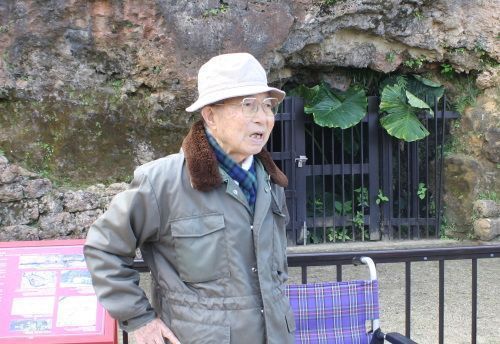90-year old former student recalls history of Battle of Okinawa remains in Shuri Castle grounds

Saneyoshi Furugen discusses his experience during the Battle of Okinawa in front of the Ryukon Cave on January 19 in Naha
January 20, 2019 Ryukyu Shimpo
On January 19, Saneyoshi Furugen, 90, a former member of the Lower House of the Diet who was mobilized during the Battle of Okinawa in the Tekketsu Kinnotai unit composed of middle school boys, discussed his wartime experience for the first time in front of the Ryukon Cave in the grounds of Shuri Castle, to which students from the Okinawa Teachers School, who were mobilized to said unit, evacuated.
Furugen gave his testimony in front of around 60 people participating in a peace education program carried out there.
He called for the cave to be opened to the public for the purpose of peace education and said, “I want to see it used as a place for contemplation so that such a tragedy is never repeated.”
The Ryukon Cave is located behind the main hall of Shuri Castle. It was dug by students from the boy’s section of the Okinawa Teachers School during the Battle of Okinawa, and was completed in March 1945 right before the U.S. military landed in Okinawa.
After the U.S. military landed, it was used as a shelter for students of the Okinawa Teachers School who were mobilized to the Tekketsu Kinnotai unit, and a part of the cave was used for publication of the Okinawa Shimpo, a newspaper in circulation at the time.
The peace education program was arranged by the civic group Shuri Peace Committee.
Participants visited the gatepost at the former entrance to the Okinawa Teachers School, which burned down during the Battle of Okinawa, near the Okinawa Prefectural University of Arts, and other locations connected to the Okinawa Teachers School, which was located in the grounds of Shuri Castle before the war.
Furugen, who enrolled in the school in April 1944, shortly before the Battle of Okinawa, recalled the ferocity of the U.S. military’s naval bombardment, saying, “The area had been full of greenery, but not a single leaf remained.
It was utterly blasted into nothing.”
Furugen shared memories of wartime in front of the cave for about two hours, such as the memory of using pickaxes to dig the trench using a three-shift system.
“People should be allowed to visit [the cave].
I hope you will all lend your assistance so that it can serve a role in peace education,” said Furugen, emphasizing the necessity of preserving the cave and using it for peace education.
(English translation by T&CT and Sandi Aritza)
Previous Article:The words “Henoko” and “Futenma” have disappeared from Prime Minister Abe’s policy speeches starting in 2014
Next Article:Low-Cost-Carrier AsiaAir X opens new route to Okinawa
[Similar Articles]
- Shelter built by students for the Japanese Imperial Army during the Battle of Okinawa to be exhibited
- Descendants of the Himeyuri Peace Corps visit the battlefield where the student nurses were mobilized for the 30-year anniversary of the Himeyuri Peace Museum
- “Peace Walk” tour around Battle of Okinawa sites in Urasoe, Naha
- “Try to imagine”–Okinawa Shogaku students teach Hiroshima high school students about the Battle of Okinawa, show them the footsteps of the Shiraume students
- Testimony by Japanese soldier of Korean descent tells of abuse by fellow soldiers
 Webcam(Kokusai Street)
Webcam(Kokusai Street)


